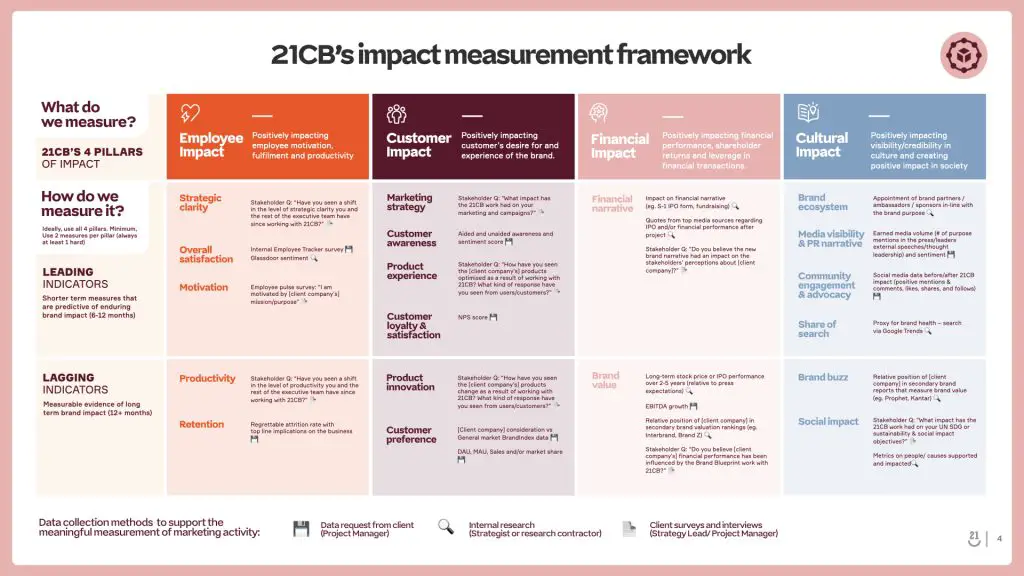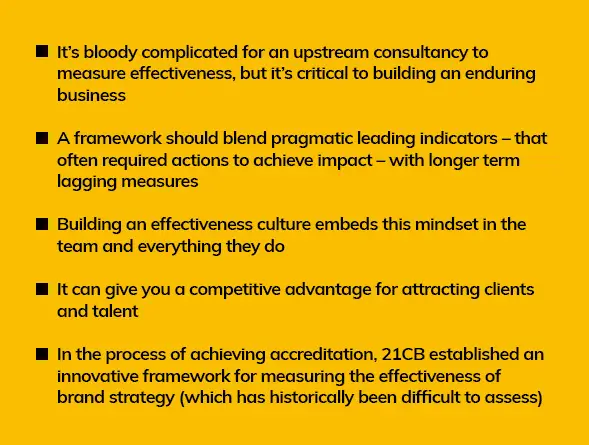 Anna Chapman, senior strategist at TwentyFirstCenturyBrand, lifts the lid on their recent IPA accreditation, discussing the approach to effectively evidence the transformative value delivered by brand building.
Anna Chapman, senior strategist at TwentyFirstCenturyBrand, lifts the lid on their recent IPA accreditation, discussing the approach to effectively evidence the transformative value delivered by brand building.
The economically challenging times we’re living in continue to persist.
Marketing spend has not recovered post-Covid and client budgets are increasingly under scrutiny. The plus side of the downturn is that it pushes us to find solutions and refine our offering. In this climate, it’s more important than ever to be able to prove the value and impact of your work. But measuring effectiveness isn’t always straightforward, particularly when your work is upstream and focused on building iconic brands with cultural impact. Given the messy reality of how brand strategy creates cross-company value over time, campaign results alone won’t cut it and the maxim ‘not everything that can be measured matters and not everything that matters can be measured’ is very apt.
Since its inception five years ago, building an effectiveness culture has remained a high priority at TwentyFirstCenturyBrand. Our CEO Neil Barrie sits on the IPA Effectiveness Leadership Group and, in 2019, we published ‘The Business Case for Creating an Iconic, Influential Brand’ a white paper based on a twenty-year academic and literature review of the ways brand investment creates business value. Last September, we set out to achieve accreditation from the IPA, a biennial endorsement for member agencies who demonstrate their dedication to effectiveness culture and set the benchmark for the industry. We were the first brand consultancy to embark on the journey among a cohort of 30 leading media and creative agencies including BBH and Essence Mediacom.
Shifting Brand From A Marketing Thing To A Company Thing
At TwentyFirstCenturyBrand we believe brand is the foundation on which the company stands and harnessed correctly it can create transformational financial, consumer, cultural and employee value. Critical to this thesis is our belief – based on our founders’ experiences building brands for the likes of Coca Cola and Airbnb – that in many ways the most effective ‘media’ for brand impact are the leaders themselves. The level of clarity, conviction and consistent noise they emanate about the brand is hugely influential on the impact the strategy will have. Working this way helps CMOs evolve the perception of brand from a ‘marketing thing’ owned by marketers and agencies, to a ‘company thing’ that all leaders can own from HR to Product to Policy. When the company becomes the creative canvas for brand activation then the potential for impact becomes bigger and multi-dimensional.
As our client Andréa Mallard, Global CMO, Pinterest states “The idea of Pinterest bringing everyone the inspiration to create a life they love allowed us to say we now have a set of principles that serves as a filter and a springboard for ideation so we can know what’s in and what should be out as a result.”
“A big reason why we’ve had the impact we have is that we’re operating brand as connective tissue versus brand as the purview of the marketing team. That felt really transformative to us as an organisation.”
Building An Effectiveness Culture
Our effectiveness culture is the outcome of the way our people, products and processes all contribute to impactful results, along with the way we measure them. From our very first year, we’ve made efforts to measure our impact on leadership clarity, conviction and decision-making through after-action surveys. This year, we built a simple framework tailored to our business offering in collaboration with some of our CMO clients; one that sets out to credibly evidence at board level, the reality of the way that brand drives transformative value across the company on different time horizons.
We laid out our four dimensions in the order they tend to take effect, starting with Employee impact which leads to initiatives that create Customer value which translates to Financial value and ultimately wider Cultural value and we identified different measures in each pillar. However not all our client challenges are the same, so we developed a bank of potential metrics that can be tailored to a project.
Defining A New Type of Effectiveness Model
In partnership with some of our clients we set out to define a blend of lagging and leading indicators to authentically reflect the messy reality of how brand strategy creates value over time. We fully acknowledge that attributing any single one of these measures to our work may not be possible but are confident that tracking the collective set over time is credible and meaningful.

TwentyFirstCenturyBrand’s Measurement Framework
Many of the measures can be drawn from internal client data including brand and employee health tracking, revenue and customer growth reporting. However, quantifying the volume and quality of cultural impact is more challenging. We have explored social listening platforms including Pulsar and Awario, but are intending to create a bespoke tracker for clients using the proprietary measurement technology of cultural data experts and future partner companies in Common Interest, our new holding group.
We’re excited about how the effectiveness culture at TwentyFirstCenturyBrand will evolve and sharpen in the future, and we’re confident from our discussions with clients that we now have the right fundamentals in place. We know that today’s brand leaders are data-rich but feel overwhelmed and often challenged to make a convincing case for the company-wide value of brand investment. Ultimately, we hope this process contributes to a better industry understanding of the true cross-company impact of brand strategy and ultimately results in the creation of more commercial and cultural value.
Key Takeaways

from Digital Marketing Education https://ift.tt/uJiYGbV
No comments:
Post a Comment